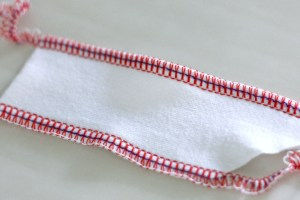Since we use the serger quite a bit in our “Sewing Knits” workshops, we always have students asking questions about the serger. As I came across this great book on serging “Ready, Set, Serge: Quick & Easy Projects You Can Make in Minutes” at the library recently, I thought I would share some of the useful information and tips featured in the book, as well as those that I have gathered from other online resources.
Differential feed
It allows you to get perfect seams with fabrics that tend to pucker and stretch.
When the differential feed is set at 1.0 (normal), the feed dogs work at the same rate. (Machines with differential feed have two sets of feed dogs: a front feed dog that controls the fabric as it goes under the foot, and a back feed dog that controls the fabric as it emerges.
When differential feed is increased (>1), you are moving more fabric through for each stitch; you will end up making small gathers. When sewing knits (or other stretchy fabric, or even woven cut on bias), increasing the differential feed would prevent a stretched seam.
When differential feed is decreased (<1), you are moving less fabric through each stitch; you will stretch out puckers. When sewing with sheer, lightweight or slippery fabrics, decreasing the differential feed would prevent puckering.
Thread tails
When you finish a seam on your sewing machine, you stop at the edge. Not so with a serger. The preferred action is to stitch off, which means that you continue to serge beyond the fabric’s edge until you have a thread tail that is long enough to be cut.

Thread tails
So, what should you do with the tail? As we normally do a lockstitch before serging in class, we tend to just cut off the tail. But, if you are only serging (and not using a lock stitch), the stitches may come undone or unravel. There are a few ways to deal with the tail, including:
Hiding. Tuck the tail back into the back into the serged seam using a double-eyed/ large-eye/ tapestry needle. Thread the tail through the eye of the needle then slide the needle back at least one-half inch under the loops of the serged seams.
Seam sealant. Clip the threads and apply seam sealant. This technique is more suitable for area that will not have a lot of wear and tear. Also, some sealants harden when dry.
Removing stitches
Unpicking serged seam is not as intimidating as it looks once you understand how each stitch is form. As only the needle threads penetrate the fabric (and looper threads do not), you only have to remove the needle thread and the looper threads will fall away.

Note: if stiff or bulky fabrics are used, the needle threads may be difficult to put out. In that case, use your seam ripper to rip the needle threads. Loopers will fall away once the needle threads are no longer in place.
Alright, that’s all for the first part. We will be back with more on stitch length, width, pressed serged seams and more. Stay tune!

Comments